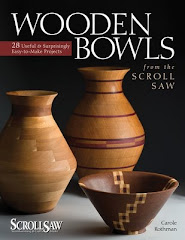I'm always looking for ways to keep scrolled bowls fresh, and decided to play around with the top rim. I've seem versions around that did this, but none that involved contouring by sanding.
The principle is pretty simple. The ring is sized extra wide, and the outside cut is made vertically, rather than at an angle. Some people leave the extra wood plain, others use fretwork. I decided to round it to create a soft look, and found it quite attractive. My own preference if for softened or rounded edges, which I think gives a more finished appearance than knife sharp ones.
This bowl had curved sides which made the designing a little tricky, and the sequence was different since you can't work as well once the top ring is attached, but everything else was standard, and I'm going to see how far I can take this before I run out of ideas.
Showing posts with label sanding. Show all posts
Showing posts with label sanding. Show all posts
Thursday, September 28, 2017
Friday, April 19, 2013
New sanding video is up and running
I just posted another sanding video on YouTube to cover some tips that I thought would be useful. They are at the opposite ends of the spectrum with regard to cost, but both are worth considering.
Labels:
drum sander,
sanding,
wooden bowls,
wooden boxes
Tuesday, March 22, 2011
Closing in on the gaps
I discovered that when a board comes off the drum sander, it may look flat without really being completely flat. This may be the heart of the problem I've been having gluing up some of my bowls.
I discovered this when I ran a freshly sanded board over the SandFlee, and noticed that the sound it made wasn't the same throughout the length of the board. When I put the board on a completely level surface, I could get a very small rocking, about 1/64" inch, barely noticeable. I gave the board a number of passes through the SandFlee, and when it sounded flat, I checked it again, and there was a tremendous improvement.
I've finished gluing up and sanding the new bowl, and had very little problem getting the rings to lie completely flat against each other. In addition, the wood I had glued together to get the pattern I wanted was so well sanded that I could not even feel where the strips were located. I guess when you're working with such close tolerances, these small differences matter.
I'll post a picture of the bowl that I made with that blank as soon as it's finished, probably by the end of the week. It was an ambitious project, using laminated swags that spanned three rings and the base. Came out quite well, and the more I understand all these nuances, the better equipped I am to help others make better bowls.
Labels:
drum sander,
SandFlee,
sanding
Wednesday, March 16, 2011
Jury still out on the SandFlee, and a new sanding tip
I finally have the SandFlee operating properly, although it took a 1/16" shim under one of the hinges to get the table level by the drum. I've installed the fence, which was an easy job. I haven't yet used it as a jointer, which is one reason why I bought it, but a preliminary test on a ragged edge looked promising. I need to plan out an interesting glue-up to give it a "field test".
However, I have been disappointed using it to flatten rings. I assumed that passing it over the roller would automatically remove any irregularities. What I seem to be finding instead is that when a ring is cut at an angle, forces may be released that prevent the ring from lying completely flat. This doesn't always happen, but has happened frequently enough to be an issue to contend with. When this happens, just sanding the gluing surface evenly, whether with the SandFlee or sandpaper glued to a flat tile, does not change things. The spaces are generally small, 1/32" or less.
What does work is selective sanding with the sandpaper glued to a tile. I look carefully at where there are spaces. You can use a flashlight or bulb, or strip of paper, to confirm. I then sand the surrounding areas that are too high by exerting unequal pressure on those spots, or if it's a corner, by just sanding that corner slightly. Then I check, and repeat the process as often as needed. The payoff is that you will not get a visible glueline between the rings. Sometimes there is enough flex in the ring for it to flatten out with pressure from the bowl press during glue-up, so it often becomes a judgment call.
The situation to avoid is a space that will not close when you exert pressure. That will result in a product that you won't be proud of. Take a break when you've "had it", then come back later. You'll be happier that you did!
Labels:
bowl press,
SandFlee,
sanding,
wood bowls
Sunday, December 20, 2009
Sanding Tools, Part I
Making bowls with the scroll saw is a sanding-intensive experience. Sanding is used both for shaping and for smoothing the bowl. Having the proper tools makes the job much easier. In addition to the standard selection (vertical belt, disc and spindle sanders) bowl making requires special equipment to sand the bowl interior and add contour. At a minimum, you'll need a flexible pad sander and a variety of grits.
This small device is best used chucked into a drill press so both hands are free to manipulate the project. Small sanding discs attach with a hook and loop system, making changing the grit a snap. Although there are many sources for this product, I use the non-tapered "flexi-pad" available from Klingspor's Woodworking Shop, in a 2" size, standard density. See the sidebar for a link to Klingspor's Woodworking Shop.
Subscribe to:
Posts (Atom)





